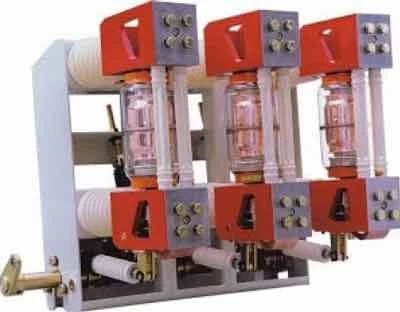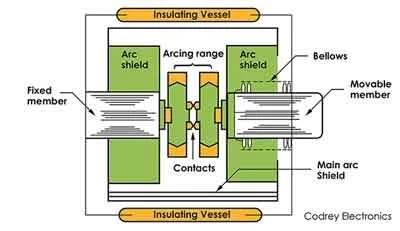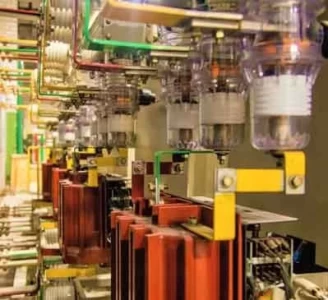Vacuum Circuit Breakers: An In-Depth Look

Vacuum Circuit Breakers (VCBs) are a critical component in electrical networks, playing a vital role in medium voltage (above 1 kV) applications. They function as switching devices, interrupting short-circuit currents and enabling operational switching (on-off operations) of individual circuits or electrical equipment. Their core functionality lies in quenching the electric arc that forms when contacts open in a vacuum environment. VCBs are widely favored due to their reliability, extended durability, and minimal maintenance requirements.
How Vacuum Circuit Breakers Work
VCBs operate on the principle of arc interruption within a vacuum chamber. When the contacts in a VCB open, an electric arc erupts between them. However, in a vacuum environment, there are very few gas molecules present to sustain the arc. Consequently, the arc rapidly extinguishes due to the absence of sufficient particles for collision ionization. This swift arc quenching allows VCBs to interrupt large currents effectively.
Types of Vacuum Circuit Breakers
Vacuum Circuit Breakers come in various configurations, each tailored for specific applications:
- Indoor VCBs: Designed for use within buildings or electrical panels, these compact VCBs are suitable for medium voltage applications in industrial and commercial power distribution networks.
- Outdoor VCBs: OBuilt for harsh weather conditions, outdoor VCBs are robust and well-suited for substations and power distribution applications.
- High Voltage (HV) VCBs: Employed in power transmission networks, HV VCBs are specifically designed to handle high voltages, typically exceeding 36 kV.
- Gas Insulated VCBs: These VCBs incorporate a unique design where they are encapsulated in a gas medium, often sulfur hexafluoride (SF6). While the arc quenching occurs in the vacuum chamber, the SF6 gas enhances the overall dielectric strength surrounding the vacuum environment.
Applications of Vacuum Circuit Breakers
VCBs boast a wide range of applications in various electrical systems, including:
- Medium Voltage Distribution: VCBs are extensively used in medium voltage distribution networks for protecting electrical equipment and feeders from fault currents.
- Substations: They play a crucial role in substations, ensuring safe and reliable power distribution by interrupting fault currents.
- Industrial Plants: VCBs are vital components in industrial plants, safeguarding electrical equipment from short circuits and enabling safe operation.
- Commercial Buildings: VCBs contribute to electrical safety and reliability in commercial buildings by protecting electrical circuits.
ACB vs. VCB: A Comparison
Air Circuit Breakers (ACBs) are another type of circuit breaker, but unlike VCBs, they utilize air as the arc extinguishing medium. Here's a quick comparison to understand the key differences:
| Feature | Air Circuit Breaker (ACB) | Vacuum Circuit Breaker (VCB) |
| Arc Extinguishing Medium | Air | Vacuum |
| Voltage Range | Up to 36 kV | Up to 72.5 kV (generally) |
| Maintenance | Requires regular maintenance | Minimal maintenance required |
| Size | Larger and bulkier | Compact |
| Applications | Lower voltage applications | Medium voltage applications |
While both ACBs and VCBs serve the purpose of interrupting currents, VCBs offer several advantages, making them the preferred choice for medium voltage applications.
Advantages of Vacuum Circuit Breakers
VCBs offer a multitude of benefits compared to other circuit breaker technologies:
- Superior Arc Quenching: The high vacuum environment effectively extinguishes arcs, enabling VCBs to interrupt larger currents safely.
- Minimal Maintenance: Unlike ACBs, VCBs require minimal maintenance due to the absence of arc erosion within the sealed vacuum chamber.
- Extended Lifespan: VCBs boast a longer lifespan compared to ACBs owing to reduced contact wear and tear.
- Compact Design: The vacuum environment allows for a more compact design compared to ACBs, making them ideal for space-constrained applications.
- Environmentally Friendly: VCBs do not rely on harmful gasses like SF6 for arc quenching, making them an environmentally friendly alternative.
Disadvantages of Vacuum Circuit Breakers
Despite their numerous advantages, VCBs also have some limitations:
- Limited Voltage Range: VCBs are generally limited to medium voltage applications (up to 72.5 kV) and may not be suitable for extremely high voltage applications.
- Sensitivity to Vacuum Loss: A breach in the vacuum chamber can render the VCB inoperable, requiring immediate repair or replacement.
- Cost: VCBs can be more expensive than ACBs due to the complex manufacturing processes involved.
Special Features of Vacuum Circuit Breakers
One of the most distinctive features of VCBs is their fast arc interruption time. Due to the rapid quenching of the arc in the vacuum environment, VCBs achieve shorter arcing times compared to other circuit breaker technologies. This translates to several benefits:
- Reduced Equipment Damage: Faster arc interruption minimizes damage to electrical equipment during fault conditions.
- Improved System Stability: The quick response of VCBs helps maintain system stability by limiting fault current duration.
- Enhanced Safety: Reduced arcing time translates to lower risk of electrical explosions and personnel injury.
Another notable feature is their sealed vacuum chamber. This design isolates the arc quenching process from the surrounding environment. This translates to several advantages:
- Reduced Fire Risk: The absence of external arcing minimizes the risk of fire hazards.
- Silent Operation: VCBs operate silently compared to ACBs, which generate a loud noise during arc interruption.
- Lower Maintenance Needs: The sealed chamber minimizes contact with contaminants, further reducing maintenance requirements.
What are Vacuum Circuit Breakers Best Suited For?
VCBs are best suited for medium voltage applications (typically ranging from 1 kV to 72.5 kV) due to their:
- Superior arc quenching capabilities for handling fault currents effectively.
- Compact design making them ideal for space-constrained environments.
- Minimal maintenance requirements ensuring cost-effective operation in the long run.
- Environmentally friendly operation by not relying on harmful gases like SF6.
Their fast arc interruption time and sealed vacuum chamber make them valuable assets in applications where:
- Equipment protection is critical, such as industrial plants and substations.
- System stability is crucial, like power distribution networks.
- Safety is paramount, like in commercial buildings and densely populated areas.
However, it's important to consider their limitations:
- Voltage range limitations may not be suitable for extremely high voltage applications.
- Sensitivity to vacuum loss necessitates proper installation and maintenance procedures.
- Potentially higher initial cost compared to ACBs.
Which is the Most Serious Problem in Vacuum Circuit Breakers?
While VCBs offer numerous benefits, a potential breach in the sealed vacuum chamber can be considered the most serious problem. This loss of vacuum renders the VCB inoperable, potentially leading to:
- Circuit protection failure: The compromised VCB may not interrupt fault currents effectively, posing a risk to equipment and personnel.
- System instability: A failed VCB can disrupt power flow and contribute to system instability.
- Safety hazards: A loss of vacuum can lead to arcing outside the chamber, increasing the risk of fire and electrical injury.
Therefore, proper installation, regular inspections, and adherence to manufacturer's recommendations are crucial to ensure the integrity of the vacuum seal and maintain the reliable operation of VCBs.
What is the Biggest Disadvantage of a Vacuum Circuit Breaker?
The biggest disadvantage of a Vacuum Circuit Breaker is its limited voltage range. While they excel in medium voltage applications, VCBs may not be suitable for extremely high voltage applications (above 72.5 kV) typically encountered in power transmission systems. This limitation arises from the need for a robust design to withstand the high electrical stresses at such voltages.
For high voltage applications, alternative circuit breaker technologies like Gas-Insulated Substations (GIS) utilizing SF6 gas as the insulating medium are often employed. However, the environmental concerns associated with SF6 gas are driving research and development into alternative high voltage circuit breaker technologies that can match the performance of VCBs.
Vacuum Circuit Breakers offer a reliable and efficient solution for medium voltage applications. Their superior arc quenching capabilities, minimal maintenance needs, compact design, and environmentally friendly operation make them a popular choice in various electrical systems. However, it's essential to be aware of their limitations in terms of voltage range and sensitivity to vacuum loss to ensure their safe and effective operation.



